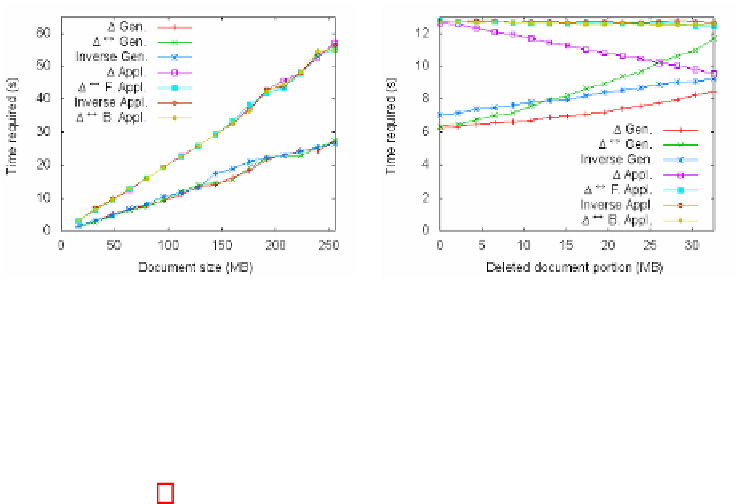Database Reference
In-Depth Information
Fig. 3.
Experiments
Given a synthetic XQU expression, we first investigated the correlation between the
size of the document and the time required for:
(
i
)
generating the corresponding PUL
Δ
/completed PUL
Δ
↔
;
applying
Δ
,
Δ
↔
,
Δ
−
1
and backward applying
Δ
↔
. In all cases, the portion of the document being in-
serted or removed is approximately 1MB. Results for this experiment are reported on
the left side of Fig. 3. Moreover, we consider a 64MB document and we vary the amount
of information removed or replaced (ranging from 0% to 50%). Results of the second
experiment are reported in the right side of Fig. 3. The experiments indicate that the
cost of generating or applying a PUL
Δ
∗
(either
Δ
,
Δ
↔
,or
Δ
−
1
) is dominated by the
number of nodes analysed. Specifically, when a PUL
Δ
or
Δ
↔
is applied, the number of
nodes in the original document, those in the updated document and those in the PUL it-
self contribute to the running time of PUL application. Analogously, for the application
of
Δ
−
1
, the number of nodes in the original document and those in
Δ
and
Δ
−
1
affect
the running time. Thus, when the portion of the document being inserted or deleted is
not relevant, PULs generation and application time are not influenced by
Δ
∗
, while ap-
plications require almost twice the time of generations. By contrast, when the size of the
deleted portions of the document increases, completed PULs become less efficient, as
the forward application time is unchanged and its generation time increases. Similarly,
when the number of nodes inserted by a PUL is high, PUL backward application time
remains unchanged, and its generation time increases, even if to a lesser extent.
computing the inverse
Δ
−
1
of
Δ
;
(
ii
)
(
iii
)
6
Related Work
The paper relies on the approach to update execution proposed in [3] which proposes
the decoupling of PUL production from PUL evaluation as an execution model for
XML updates expressed through XQU expressions in distributed contexts. The need
of more flexible mechanisms for update handling entails the development of suitable
mechanisms for reasoning on updates before actually apply them, and specifically for
composing as well as reverting them. In [3], PUL operators for composing updates (in-
tegration and aggregation) as well as for devising a compact representation (reduction)
are investigated, but inversion is not addressed.



